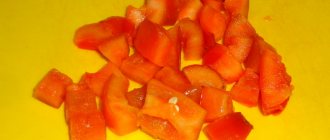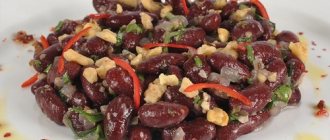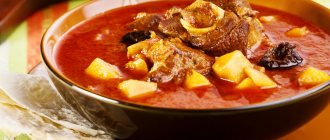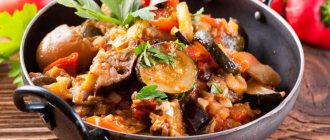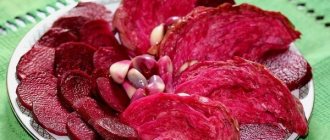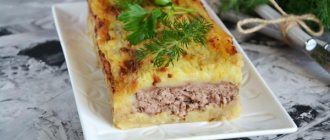Ojakhuri - a simple and tasty dish from Georgia
Ojakhuri is a national dish of Georgian cooks, consisting of fried meat and potatoes, which are the perfect combination. To prepare the roast, various types of meat (pork, beef, chicken), spices are used, and traditionally it is served on ketsi. The Georgian dish ojakhuri is usually prepared for the whole large family, because this dish is considered a family dish.
The calorie content of the dish ranges from 180 to 215 kcal per 100 g, depending on the fat content of the meat component. In this material we will look at how to prepare ojakhuri in several popular variations step by step and with photos.
Classic ojakhuri recipe
This recipe contains very simple ingredients, prepared in a rather unusual way. We most often stew these products together, but here they need to be fried separately from each other. This roast ends up with a wonderful, rich flavor that can convey the atmosphere of home.
- One onion;
- Pork meat – 220 g (neck);
- Large tomato;
- Potatoes – 250 g;
- Basil, dill - to taste;
- Garlic – 3 cloves;
- Spices, salt - to taste;
- Vegetable oil – 90 ml.
The classic ojakhuri recipe looks like this:
- Add vegetable oil to the frying pan and heat it well;
- Cut the pork into small pieces and fry in hot oil until golden brown;
- Peel the onion and chop it into thin half rings;
- Add the chopped vegetable to the meat in a frying pan and fry until it acquires a golden hue;
- We clean the potato tubers and fry them separately until golden brown over high heat (you can use deep frying), pepper and salt, put them in a frying pan with the other ingredients, stir everything and fry further;
- Cut the peeled garlic into strips and also add it to the frying pan;
- Now salt the pork ojakhuri, season with spices and fresh herbs;
- At the end of cooking, add the tomato, cut into slices, and fry for 2-3 minutes;
Place the finished culinary masterpiece in plates, sprinkle with herbs and serve.
Ojakhuri on ketsi
In this dish, ordinary meat and potatoes are transformed into juicy and flavorful products. The traditional way of preparing and serving food can be called ojakhuri on ketsi - a special clay frying pan. In a familiar frying pan, pieces of meat are simply stewed or scalded, but in a clay frying pan, the whole range of delicious meat juices and aromas of spices is preserved, and a crispy crust is formed. In this case, you need to cook the dish for a few more minutes after removing it from the heat.
- Potatoes – 600 g;
- Tomatoes and onions – 2 pieces each;
- Pork ribs – 1.5 kg;
- Red wine – 100 ml;
- Suneli hops and dry adjika – 5 g each;
- Cilantro - a handful.
The step-by-step recipe is:
- Cut the meat pieces and marinate for 6 hours in spices and wine;
- We cook the potatoes in deep fat;
- Heat the ketsi and fry the meat and onion, cut into rings;
- Add chopped tomatoes and potatoes, sprinkle with herbs;
Ojakhuri
Ojakhuri is fried meat and potatoes cooked on ketsi. The name is translated from Georgian as “home” or “family”. The dish is simple, satisfying and very tasty, just what you need for a family lunch or dinner.
By pre-marinating the pork in red wine and spices, the usual “meat and potatoes” is transformed into a colorful Georgian dish. Ojakhuri is made from pork (beef or chicken is less commonly used) and potatoes, which are deep-fried. At the final stage, the dish is generously sprinkled with pickled onions and herbs. Often the ingredients include tomatoes that undergo minimal heat treatment - fresh tomatoes are cut into slices and placed in a frying pan at the end of frying so that they retain their shape and add sourness to the dish. Spices traditionally used are suneli hops, coriander, cumin, and pepper.
What is ketsi?
Today I will tell you how to cook ojakhuri in Georgian on ketsi - that’s the name of a special frying pan made of red clay or stone. The method of cooking on ketsi differs in many ways from cooking in our usual glazed dishes (pots and other baking dishes). Here the dish is not stewed or boiled. Valuable juices do not leak out of the pieces of meat; on the contrary, a confident crispy crust forms on the surface.
Ketsi is suitable for cooking on the grill, in the oven or on a gas stove. In the latter case, to prevent the clay from cracking from an open fire, be sure to use a divider, which helps to heat the dishes evenly and very slowly. Traditionally, ojakhuri is prepared on clay ketsi. It keeps the temperature well, the meat turns out soft, the potato crust remains crispy, and the aroma is amazing! Ketsi is capable of maintaining a high temperature for a very long time, so the dish prepared in it is served to the table with a plate placed underneath so that it remains hot.
What to do if there is no ketsi?
In this case, use a heavy, thick-bottomed cast iron pan or grill pan. The cookware must be very hot, so thin Teflon-coated pans are not suitable.
Which meat is better to choose?
Pork is traditionally used for ojakhuri. The meat should not be stringy or dry. The best choice would be the neck - this cut is soft, with small layers of fat that will render and make it juicy (like a shish kebab). Alternatively, you can use pork ribs. In this case, you will need to cut all the meat along the bone to get pieces up to 5 cm.
Ingredients
- pork (neck) – 500 g
- potatoes – 500 g
- dry red wine – 100 ml
- khmeli-suneli – 1 tsp.
- ground coriander – 1/3 tsp.
- red pepper adjika – 1/3 tsp.
- ground black pepper – 1/2 tsp.
- purple onion – 1 pc.
- red wine vinegar - 1 tbsp. l.
- vegetable oil - for deep frying
- salt - to taste
- garlic – 1 tooth. optional
- greens (parsley, cilantro, basil) - to taste
Note. The amount of ingredients in the recipe is based on 1 generous serving, which will fit into 1 ketzi with a diameter of 20 cm.
Preparation
Cut the meat into pieces up to 5 cm. Place in a bowl, sprinkle with hops-suneli and ground coriander, add a little adjika (meaning Megrelian adjika made from red pepper, can be replaced with hot ground chili). Pour dry red wine, stir well. Keep the meat in the marinade for at least 6 hours in the refrigerator. If for some reason you don’t like wine marinades, you can sprinkle pieces of pork with Svan salt and rub them with your hands with a small diced onion - it will also turn out very tasty.
Once the pork is marinated, proceed to the next step. Cut purple onions (Yalta or Mars varieties are suitable) into half rings, pour a glass of cold boiled water with vinegar. After 10-15 minutes, drain the liquid.
Prepare the potatoes. Peel about 5-6 tubers, cut into slices of approximately equal size - into 6-8 pieces. There is no need to chop it too small; the pieces should keep their shape well and not fall apart. Heat vegetable oil (refined) in a saucepan, take a lot so that the potato slices can float freely in it and literally drown. Fry the potatoes in boiling oil until a nice crust forms. Once fried, transfer to a plate and set aside, keeping warm. In general, it is better to do this at the same time as frying the meat, so that the potatoes do not have time to cool.
Warm up the clay ketsi slowly - be sure to use a divider on a gas stove! This way the dishes will heat evenly and will not crack. The pan should be hot. If you don’t have ketsi yet, then use a regular cast iron frying pan. I repeat that any glazed clay products and Teflon utensils are not suitable for preparing ojakhuri!
Squeeze the meat from the marinade and place it in hot ketsi (dry, no need to lubricate it with anything).
Fry on all sides until golden brown, about 10-15 minutes. Do not rush to immediately turn over the pieces of pork; the meat is fried in a ketsi a little slower than in a regular frying pan; give it time for the crust to form.
Add fried potatoes to browned meat. Continue cooking everything together for another 6-8 minutes. Remember that when you remove the pans from the stove, the cooking process will not stop - the ketsi will remain hot for a long time. So don't dry out the pork! At the very end, add salt to taste. Gently stir the contents of the ketsi and remove from the heat. If desired, you can add a chopped clove of garlic at this stage if you like.
Serve ojakhuri on ketsi immediately (use wooden stands). Before serving, sprinkle with red onion and chopped herbs.
An excellent addition to the dish will be homemade pickles - mzhave kombosto, pickled cucumbers and pickled peppers. Bon appetit!
Description of preparation:
This wonderful dish is translated from Georgian as “family”, it is intended just for a quiet dinner or lunch with the family.
And if you also like simple home cooking, I will be happy to tell you how to cook ojakhuri in Georgian. For this we need very few ingredients: meat, potatoes, onions and some spices, but even with such a small number of ingredients the dish will turn out amazing. True, I do not recommend preparing ojakhuri in Georgian style at home for those who are watching their figure, because such a dish is quite high in calories, although from time to time it is worth pampering yourself, especially since it is really incredibly tasty. Purpose: For lunch / For dinner Main ingredient: Meat / Vegetables / Beef / Potatoes Dish: Hot dishes Geography of cuisine: Georgian / Caucasian
Ojakhuri - recipes for a delicious Georgian dish
Ojakhuri is a recipe with which ordinary potatoes and meat are transformed into a juicy, aromatic Georgian family dish. Generously seasoned with traditional suneli hops, ripe tomatoes and fresh herbs, it has a rich taste, appetizing appearance and belongs to the rare category of dishes that can convey a homely atmosphere.
How to cook ojakhuri?
Ojakhuri in Georgian is high-quality meat and vegetables, spices and fresh herbs. According to the rules, fatty pork and veal are used. For softness and taste, the meat is marinated in wine or lemon juice. The dish is prepared simply: meat and potatoes are fried separately, combined, seasoned with spices, tomatoes and served immediately.
- pork neck – 450 g;
- potatoes – 4 pcs.;
- onion – 1 pc.;
- oil – 50 ml;
- lemon juice – 80 ml;
- clove of garlic – 3 pcs.;
- tomato – 1 pc.;
- hops-suneli – 5 g;
- ground black pepper - a pinch;
- cilantro and basil - a handful each.
- Marinate the pork pieces in oil and lemon juice for 3 hours.
- Deep fry the potato slices.
- Fry the meat with onions.
- Add potatoes, garlic, spices and tomato slices.
- Simmer covered for 3 minutes.
- Ojakhuri with pork is decorated with herbs and served immediately.
Ojakhuri on ketsi - recipe
Ojakhuri on ketsi is a traditional way of preparing and serving the dish. Unlike a conventional frying pan, where meat is simply stewed or scalded, in a clay pan, meat juices and the aroma of spices are preserved and a crispy crust is formed. It should be remembered that meat in clay ketsi cooks for a few more minutes after removal from the heat.
- pork ribs – 1.5 kg;
- potatoes – 600 g;
- onions – 2 pcs.;
- tomatoes – 2 pcs.;
- hops-suneli – 5 g;
- red wine – 100 ml;
- dry adjika – 5 g;
- cilantro - a handful.
- Cut the meat and marinate in wine and spices for 6 hours.
- Deep fry the potatoes.
- Warm the ketsi and fry the meat and onion rings.
- Add potatoes and tomatoes.
- Ojakhuri is a recipe that involves simmering on ketsi for no more than 7 minutes.
Ojakhuri with mushrooms
The Georgian dish ojakhuri can turn into a lean dish if the meat is replaced with mushrooms. They go well with potatoes and tomatoes, cook quickly, and make the dish nutritious and low in calories. All you need is to fry them with onions until golden brown and combine with potatoes, tomatoes and spices, which will give the food a Georgian flavor.
- champignons – 200 g;
- potatoes – 3 pcs.;
- onions – 2 pcs.;
- tomato – 1 pc.;
- ground black pepper - a pinch.
- Before preparing ojakhuri, deep fry the potatoes.
- Cut the champignons into 4 parts and fry with onions.
- Add potatoes and tomato slices and season.
- Ojakhuri is a mushroom recipe that “ripens” on the stove for another 5 minutes.
Ojakhuri in Georgian “camping”, in a cauldron
This dish is a real salvation if you go on a picnic in nature and make a fire! Thrifty cooks have a large cauldron with a thick bottom in their arsenal if they often make forays into the forest and like to cook there.
What products are needed to cook ojakhuri in a cauldron:
- pork with fat (in the cauldron the meat will “lean” against the walls, and no matter how much oil you pour, there won’t be enough oil);
- large potatoes;
- onion;
- salt and pepper;
- tomatoes;
- greens to the taste of the cook.
Where is the weight of the products, you ask? When preparing ojakhuri, if you notice, the proportion is 1 (meat) – 2 (potatoes) – 0.5 (onion). Always! We take as much food as will fit in the cauldron, we don’t regret it - in nature the appetite will be so great that the dish will “fly away” instantly, no matter how much you prepare.
Cut the meat into medium pieces, throw it into a cauldron (oil has already been poured into it), and fry, stirring continuously. The potatoes have already been peeled, the onion has been cut - add it to the cauldron, add a little water and cover with a lid. Periodically you need to look into the cauldron and stir everything so that it doesn’t burn at the bottom.
As soon as the potatoes become soft, add halved tomatoes to the future ojakhuri. Leave on the fire for a few minutes (the tomatoes are on top, they release juice), add salt and pepper, mix again, sprinkle with herbs and remove everything from the heat, closing the lid before doing so. No longer on the fire, the dish should “cook” for a couple of minutes. Place on plates, hembrielat miirtvit (in Georgian - bon appetit)!
Ojakhuri in Georgian is a dish that seems completely easy to prepare. Reading the recipe, laid out step by step, is a simple science, but you need to know the required tricks so that the ojakhuri is “correct” and everyone likes it.
Ojakhuri
The generous Georgian cuisine reveals a thousand and one dishes to us! This recipe is for all lovers of a hearty combination of meat, onions and fried potatoes. Spices, garlic and fresh herbs will highlight the traditional splendor of flavors and give it a bright Georgian touch.
Author of the publication
Olsan Uvarova
Olsan Uvarova
Journalist by profession, cook by vocation. Cooks quickly while the kids are sleeping. Appreciates spectacular presentation and sophisticated author's style in cooking. Tells how to disarm the most picky guest with an exquisite but easy-to-prepare dish.
Prepare the ingredients. Wash the meat.
Peel and wash the potatoes. Cut each tuber in half lengthwise, then cut each half into another 3-4 slices.
Heat vegetable oil in a cast iron skillet or deep fryer. Fry the potato wedges until golden brown, about 5-6 minutes.
When the potatoes are ready, place them on paper napkins using a slotted spoon.
Peel the onion and cut into half rings.
Peel the garlic, chop finely.
Peel the red onion and cut into feathers.
Cut the meat into medium cubes. Fry the pork in vegetable oil for 10 minutes over high heat, then cover with a lid and fry for another 10 minutes until done, without adding spices. Stir the meat occasionally while frying.
Add onion to the meat and fry for another 5 minutes without a lid. Add prepared potatoes, salt, suneli hops, cilantro, chopped basil and garlic. Fry for another 5 minutes.
Ojakhuri
ready! Serve hot with fresh herbs and red onion. Bon appetit!
Classic ojakhuri recipe in Georgian
This recipe is the simplest, without additional additives, an old “classic” dish just like that.
Products:
- medium fat pork, preferably boneless – 1 kg;
- large potatoes – 2 kg;
- pink or white onion – 0.5 kg;
- ground black pepper;
- salt;
- parsley and oregano.
Pour vegetable oil generously into a frying pan set on fire. Fry the onion, cut into half rings, in oil until half cooked. Attention: after frying the onion, remove it and do not leave it in the pan. Many recipes do not pay attention to this or write that meat is added later, but this is a terrible mistake! Even if you take young, tender pork, while it is frying, the onion will burn. So, take out the onion and turn up the heat to maximum.
Place the pork in a frying pan, stir it and fry until crispy. Do not add salt or pepper, otherwise it will become tough. The potatoes have already been peeled and cut into quarters. Another important detail is that potatoes for Georgian ojakhuri are always cut large, otherwise they will turn into porridge. Place potatoes into the fried pork, mix everything well, cover with a lid (do not turn down the heat).
When the crackling becomes very loud, carefully remove the lid and thoroughly mix the future ojakhuri. The dish is simple to prepare, but it requires some dexterity to stir everything several times over high heat. So, periodically closing and opening the lid, fry everything until the potatoes are ready. When it is completely fried, add the onion, salt and pepper, and stir well again. Place the lid on the pan one last time for a couple of minutes (so that it steams a little), open it and sprinkle with coarsely chopped herbs - parsley and oregano. It is better to take dark oregano (another name is basil) - it has more aroma, but if you don’t like the too strong smell of dark, take green.
Carefully, so that the greens do not mix with the rest of the food, place them on plates and enjoy the food.
Ojakhuri
The generous Georgian cuisine reveals a thousand and one dishes to us! This recipe is for all lovers of a hearty combination of meat, onions and fried potatoes. Spices, garlic and fresh herbs will highlight the traditional splendor of flavors and give it a bright Georgian touch.
Author of the publication
Olsan Uvarova
Ingredients
- 900 g pork neck
- 1.2 kg potatoes
- 170 g onion
- 100 g red onion
- 3 cloves garlic
- 500 g vegetable oil
- 1 tbsp. khmeli-suneli
- 1 tsp cilantro
- 30 g basil
- 1/2 tsp. ground black pepper
- 1 tbsp. salt



